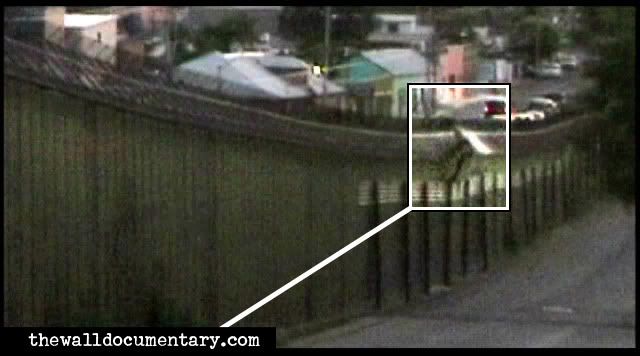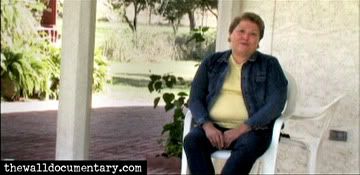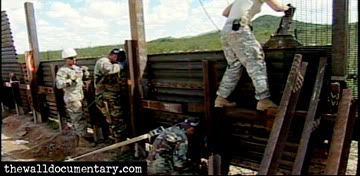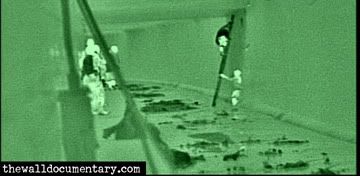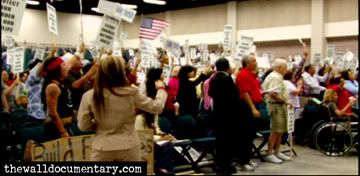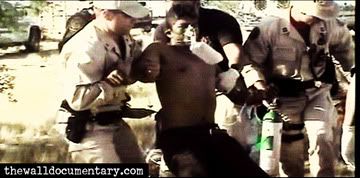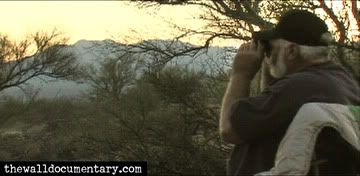Victoria Advocate
June 28, 2009
Gabe Semenza
Eloisa Tamez is the first Texan who refused to sign federal paperwork that would allow U.S. Homeland Security to build a border fence in her backyard.
As hundreds of other Texas landowners like her soon learned, citizen defiance rarely trumps eminent domain.
Now, as contractors erect the last portions of U.S. border fence in the Rio Grande Valley, Tamez speaks out again. The government took the 74-year-old's land, she said, but federal authorities will never silence her voice.
Her story illustrates the emotional damage suffered when a steel border fence splits an ancient family plot in two.
Environmentalists, municipal and business leaders, each with their own concerns, cry out, too.
While critics voice deep-rooted concerns, U.S. Border Patrol agents from San Diego to Brownsville say the fence works. All along the Southwest border, it does its job, they say.
In the slippery fight to secure this country's borders, one thing is certain: Never in U.S. history has a wall on home soil divided so many people.
PARTIAL INCARCERATION?
Tamez pointed to where she once picked tomatoes as a child. Each nook holds a memory. She lives where her ancestors, her father, farmed the land.
Her family has owned this land, 15 miles west of Brownsville, for 246 years. The king of Spain granted the family 12,000 flat, grassy acres in 1763.
Steadily, her family lost the soil to the Mexican War of Independence, the U.S. annexation of Texas and the Great Depression.
In 1936, the United States and Mexico signed a treaty and formed the International Boundary and Water Commission. Federal contractors then built a levee, a dirt mountain that winds just north of the low-lying river delta to keep floodwater from devouring U.S. homes and businesses.
The levee is only 100 yards south of her home.
The boundary water treaty forbids construction on U.S. soil south of the levee. New structures here could deflect floodwater into Mexico. So it had to be, by law, that contractors built the border fence into, on top of or north of the levee.
The 20-foot-tall border fence is the first thing Tamez now sees when she steps outside. The steel barrier splits in two the last three acres of her family's original 12,000-acre tract.
"Pretty, isn't it," she said, smirking. "Everybody's land was split by the levee. What happened then is similar to what happened now."
A handful of Valley homes and an estimated 36,000 acres, most of which is privately owned, rests south of the border wall.
To reach the portion of her land blocked by the wall, Tamez must walk 3,200 feet west, or 2,200 feet east, along a dirt federal right-of-way to one of two pedestrian gates. Farmers who move cattle take similar routes.
Tamez lives in El Calaboz. The Spanish word means "jail."
"We have partial incarceration, don't we?" Tamez said.
BULLDOZING RIGHTS, LAWS
Congress ordered the U.S. Department of Homeland Security in 2006 to secure one-third of the country's 2,000-mile border with Mexico. The design called for 370 miles of pedestrian fencing and 300 miles of vehicle barriers.
Contractors will finish the last 30-mile stretch in the Rio Grande Valley by year's end.
Before the first wall sections went up, talk about its impact alarmed Tamez and others.
"When you think about the border, you're talking about the river. But I'm a mile from the river. I didn't think it would affect me," Tamez said.
In August 2007, a U.S. Border Patrol agent told Tamez her land was in the path of the proposed wall. She needed to sign a release form so engineers could survey her land.
Landowners from Brownsville to Granejo received similar calls. In Hidalgo and Cameron counties, two of the country's poorest and most uneducated counties, many residents signed release forms out of fear.
Tamez, though, has a PhD. The widow is an associate professor of nursing at the University of Texas at Brownsville. She couldn't reason away the fear, despite her education.
"My whole body was shaking. Yes, this wall was going to happen right in my backyard," she said.
Despite her fears, she refused to sign the paperwork. Her courage prompted confidence in many others. Three-hundred Texans declined to sign the federal paperwork.
Corinna Spencer-Scheurich is a lawyer with the South Texas Civil Rights Project, a nonprofit group that represents a number of Valley landowners who can't afford hefty legal defenses. She represents Tamez.
"In the beginning, a lot of people were scared," the lawyer said. "It's already uneasy to live in an area that's so militarized."
In 2008, Tamez was the first to file a class-action lawsuit - Tamez and Benito Garcia vs. Michael Chertoff - against the federal government in protection of her land. She alleged federal agencies wrongfully tried to take her land and infringed on her civil rights.
She held off border fence construction until April 16, just a few months ago. On a Friday, a federal judge in Brownsville condemned her land. By Monday, the fence went up next door and by Tuesday, the steel split her plot.
"They basically bulldozed every right they could," Spencer-Scheurich said. "A lot of people didn't want to rock the boat. Eloisa Tamez stood up and said, 'This isn't right. This is important to me.' "
DAMAGING WILDLIFE?
Infringed property rights aren't the only motivation for opposing the border wall. Activists, environmentalists and business leaders stand against the wall for various other reasons.
Scott Nicol said the wall's $49 billion cost, ineffectiveness and unintended consequences result in an historic debacle. The 39-year-old South Texas College professor founded No Border Wall Coalition to fight construction in the Valley.
"It's irrational. It just smacks of racism," Nicol said. "Somehow, we're scared of Mexico. On a fundamental level, the wall offends me."
For the Department of Homeland Security to build the wall, it needed legislation. Congress passed the Real ID Act in 2005. The act gave authority to waive 36 federal laws, including the Safe Drinking Water Act, to build the wall in record time.
"It's insane to think immigration violations are more important than the basic rule of law in the United States," Nicol said. "They're saying we'll set aside all the rules of law to build this thing. It's un-American to do that."
Nicol toured the World Birding Center, located at the Old Hidalgo Pump House just south of McAllen. The border fence splits this eco-tourist destination in half, blocking visitors from enjoying once-accessible nature trails, and wildlife from roaming easily to the river.
Nicol walked up the levee, ran his hands across the rusty steel pickets, and said the fence only pushes immigrants into harsher terrains.
Since construction of the wall began, more than 5,000 migrant bodies were found in the desert, federal records indicate.
Because the fence bisects several national wildlife refuges, animals might face similar fates.
Nancy Brown is a U.S. Fish and Wildlife expert. She said endangered and other animals can no longer easily roam from one side of the river to the other. Weaker animals run into a fence when fleeing predators, and migratory birds lost thousands of acres of brush, she said.
"The wall is doing tremendous damage to the wildlife refuges, which are supposed to be linked by the Rio Grande," Brown said. "They just emasculated that property. It's all damaging to wildlife."
DAMAGING ECONOMIES?
Eco-tourism such as bird watching is big business in the Valley. The industry generates $125 million a year and helps boost much of the impoverished region.
Sixty percent of McAllen's retail sales go to Mexican nationals. Valley business leaders fear the wall acts as a "Keep Out" sign to international customers and vacationers.
Chad Foster is mayor of Eagle Pass. He's also the chairman of the Texas Border Coalition, a group of judges, politicians and business leaders who oppose the fence.
"We support border security. We advocated the removing of cherizo cane, hiding spots on the banks. We supported technology, light towers and more Border Patrol agents," Foster said.
The federal government sued his city as it did Tamez to build the wall. Like most who lost their fight with the government, Foster said politicians far away in Washington, D.C., made decisions here without fully realizing the realities on the border.
"One size does not fit all. Of the 2,000-mile border with Mexico, Texas enjoys 1,250 miles. We have a very defined border, the river," he said. "In Arizona, where there is no definitive border, I can see where you might need to establish a physical border. Building a fence sounds good to Middle America, but it will only slow immigrants."
U.S. Border Patrol estimates the fence slows illegal immigrants between four and six minutes.
John McClung calls the fence, then, a costly speed bump. The president of the Texas Produce Association, which represents citrus growers, said the wall is ineffective.
"It was hopeless from the beginning," he said.
From the view at his home near the Santa Anna Wildlife Refuge, which is split by the wall, he said the design is too porous. Because the border wall is and will be erected in Texas in various spans - a mile stretch here, four miles there - the gaps are glaring holes in a $12 million-per-mile blunder, he said.
"The wall all along was a political statement in which deadbeat ideologues in D.C. could go back to their constituents and say, 'Look at what we did.' A real monument to idiocy," he said. "It's a total federal boondoggle."
GIVE BORDER PATROL A FIGHTING CHANCE
Not everyone in the Valley opposes the border fence.
In Granejo, a 500-member community in which most residents are related, the border wall begins at one end of town and stops at the other. While most in this tight-knit, one-road town oppose the wall, dozens didn't. Just west of McAllen, Granejo was a hotbed for illegal drug and human smuggling.
"Things changed. There were a lot of robberies here in Granejo," said Manuel Olivarez, 65. "Little kids were coming from Mexico and they were robbing us during noontime. Since that wall was built, it stopped the robberies. It stopped crime."
Mario Olivarez, a 54-year-old who lives near his brother, agrees.
"It has curbed the crossing of illegal immigrants through my land. At times, there'd be 15 or 20 people hiding back there," he said. "The only option they have is to go around us. It's made it more peaceful at night around here."
Chris Simcox, founder and former president of the Minuteman Civil Defense Corps, said the wall works. His group patrols the Southwest border to spot illegal immigration.
In Arizona, he said, the wall forged a noticeable dip in the number of illegal crossings.
"It gives Border Patrol a fighting chance," Simcox said. "When it comes to sovereignty and safety, the environmental issues pale in comparison to the need for the wall."
THREE-PRONGED ATTACK
From Brownsville to San Diego, U.S. Border Patrol agents say the wall works. Claude Knighton, a spokesman for U.S. Homeland Security, notes the wall is just one component of the Secure Border Act.
"We wanted to get effective control of the border, to reduce illegal immigration," Knighton said. "That means having the right mix of personnel, technology and infrastructure. We know the fence won't stop anyone. It's there to slow."
As part of the three-pronged initiative, the number of Southwest Border Patrol agents increased from 13,297 in 2007 to 15,422 in 2008, a 16 percent spike.
Remote and mobile surveillance systems, in-ground sensors, aerial technologies, retrofitted vehicles and new patrol roads also help agents to catch illegal immigrants, who now have a smaller, more scanned playing field in which to cross, he said.
"Apprehensions are down from 2005. We think we can attribute that to the systems," Knighton said.
Along the Southwest border, total apprehensions of illegal immigrants decreased by 20 percent from 2007 to 2008, a sign supporters say fewer people are entering into this country.
The system appears to be a success in Arizona.
DECREASE IN ILLEGAL CROSSINGS
In the Yuma Sector, the Border Patrol's model sector, numbers are striking. In 2005, agents there caught 138,000 illegal immigrants. Last year, they caught 8,600, a 94 percent dip in apprehensions.
Michael Lowrie is a Yuma Sector Border Patrol agent.
"The wall has helped. They are trying other places," Lowrie said. "They figure it's too hard to come in through Yuma. We have so few coming in every day, we have the space, time and money to prosecute everybody."
Unlike in Texas, where the wall sporadically dots its 1,200-mile border with Mexico, 117 of the Yuma Sector's 126 border miles are protected by barrier. Most of the fence went up on federal land.
"Local crime is down. It cut down on car chases and stolen vehicles, too," Lowrie said. "Everything decreased."
In the neighboring Tucson Sector, agents tell similar stories. In 2006, Tucson Sector agents caught 392,000 illegal immigrants. Last year, they caught 317,000. Of its 262-mile border with Mexico, 220 are lined with border barriers.
"We have had a dramatic decrease each year," said Michael Scioli, a Tucson sector agent.
In the Rio Grande Valley, agents report fewer apprehensions in areas where the wall is in place. Apprehensions in this sector are down 25 percent, to 41,000, from last year.
"The gaps are working as planned because it's moving illegal activity away from communities," said John Lopez, a Rio Grande Valley border agent. "The fence moves traffic to areas where we can react more safely, effectively. It's safer for us to apprehend someone in an open field than it is in a neighborhood, and it's safer for those communities, too."
AN EROSION OF DEMOCRACY?
Critics say the shaky U.S. economy is the culprit for fewer Border Patrol apprehensions. Fewer jobs deters immigrants better than any fence does, they say. Others say elimination of the Border Patrol's catch-and-release program scares away immigrants, who, if caught, now face potential prison time.
U.S. citizens also face new realities. The joke in the Valley is that landowners will need a passport to visit their land south of the wall.
Tamez, the first Texan to fight the federal government for her land, has yet to walk on her land south of the giant steel fence.
In September, she walks again into a courtroom to fight for just compensation. U.S. Homeland Security wants to pay her for the footprint of the wall, and the 100-foot right-of-way. Tamez wants the devaluation of her property to be included in the tab.
The government sought a little more than one of her three acres. Because she wasn't consulted, she doesn't know just how much they took.
With so little land left of her family's original 12,000 acres, she grasps at the last bit of soil she links to a rich heritage.
"This symbolizes an erosion of democracy. We've gone to other parts of the world and said, 'Tear that wall down.' Are we at war with Mexico?" she said.
Inside, her living room appears to have remained unchanged in decades. On one wall, an old Curtis Mathis TV; on the other, an aged flower-print sofa. She crossed her legs and bobbed her right foot.
"The government has done it before," she said. "They take my land, but they will never take my voice. We're drained, exhausted, emotionless. We have been abandoned by our own country."
http://www.victoriaadvocate.com/news/2009/jun/28/gs_fatal_funnel_14_062809_54666/?news&fatal-funnel
